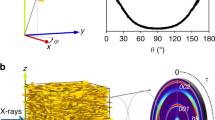Abstract
CLAY particles deposited from a suspension on to a cellulose film are usually strongly orientated with their basal (001) planes parallel to the film. Electron diffraction patterns obtained with the beam normal to the film reveal only the (hk0) diffractions. For most types of clay the corresponding spacings are so alike that such diffraction patterns do not help in identification.
This is a preview of subscription content, access via your institution
Access options
Subscribe to this journal
Receive 51 print issues and online access
$199.00 per year
only $3.90 per issue
Buy this article
- Purchase on Springer Link
- Instant access to full article PDF
Prices may be subject to local taxes which are calculated during checkout
Similar content being viewed by others
References
Bradley, W. F., Amer. Min., 25, 405 (1940).
Author information
Authors and Affiliations
Rights and permissions
About this article
Cite this article
KNAPP, D., MITRA, R. Electron Diffraction by Clay Minerals with a Fibrous or Rod-like Habit. Nature 168, 380–381 (1951). https://doi.org/10.1038/168380b0
Published:
Issue Date:
DOI: https://doi.org/10.1038/168380b0
This article is cited by
-
Basal reflection of electron waves by orientated aggregates of clay minerals
Die Naturwissenschaften (1955)
Comments
By submitting a comment you agree to abide by our Terms and Community Guidelines. If you find something abusive or that does not comply with our terms or guidelines please flag it as inappropriate.



